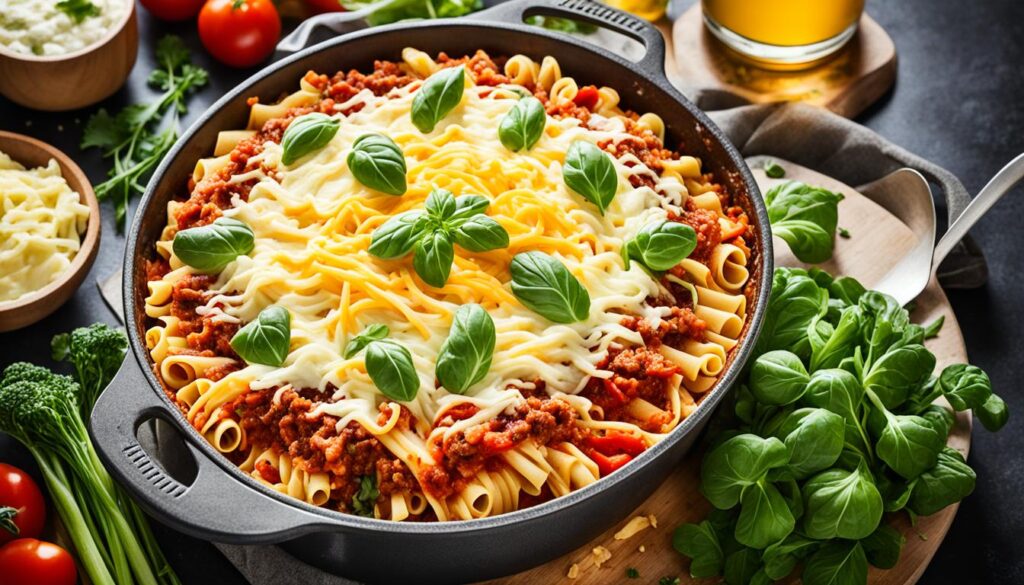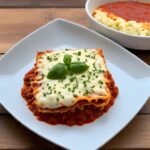Low-Carb Lasagna with Cauliflower Noodles
When it comes to low-carb diets, finding alternatives to favorite comfort foods can be a game-changer. Luckily, cauliflower noodles have emerged as a versatile substitute for carb-heavy pasta. Whether you’re following a low-carb or keto diet, or simply looking to add more veggies to your meals, cauliflower noodles can provide a satisfying and flavorful base for your favorite dishes.
One dish where cauliflower noodles truly shine is lasagna. Traditionally made with layers of pasta, meat sauce, and cheese, lasagna is a beloved comfort food that can be high in carbohydrates. But with cauliflower noodles, you can enjoy a guilt-free lasagna experience that won’t derail your low-carb lifestyle.
So how do cauliflower noodles hold up in lasagna? Let’s explore how to make and assemble a low-carb lasagna with cauliflower noodles, and discover the tips and tricks for creating a delicious and nutritious dish that will satisfy your cravings without the carb overload.
Key Takeaways:
- Cauliflower noodles are a low-carb alternative to traditional pasta in lasagna.
- They provide a nutritious and flavorful base for layering sauce and cheese.
- Making cauliflower noodles for lasagna is a versatile and easy process.
- Ensure to squeeze out moisture from cooked cauliflower to maintain noodle shape.
- Customize your cauliflower noodles lasagna with different meats, vegetables, and cheese.
A Versatile and Easy Cauliflower Pasta Recipe
Making homemade cauliflower noodles is a simple and versatile way to create delicious low-carb dishes. Whether you’re a vegetarian, following a keto diet, or simply looking for a healthier alternative to traditional pasta, cauliflower noodles are a fantastic option. They are packed with nutrients, low in carbohydrates, and easy to prepare.
To make homemade cauliflower noodles, start by ricing the cauliflower. This can be done using a food processor or a box grater. Once the cauliflower is finely grated, it’s time to mix it with eggs and seasonings. The eggs help to bind the cauliflower together, creating a dough-like consistency that can easily be shaped into noodles.
Spread the cauliflower mixture onto a baking sheet lined with parchment paper. Use a spatula or your hands to flatten and shape the mixture into a thin layer. Bake the cauliflower noodles in the oven until they become golden brown and dry to the touch. This process usually takes around 20-25 minutes, but may vary depending on your oven. Be sure to monitor them closely to avoid burning.
Once the cauliflower noodles are baked and cooled, they are ready to be used in various recipes, including as a base for vegetarian cauliflower lasagna. Layer the noodles with your favorite sauce, cheese, and vegetables to create a flavorful and satisfying dish. The cauliflower noodles provide a tender and slightly nutty flavor that complements the other ingredients perfectly.
If you’re following a keto diet, cauliflower noodles are an excellent option as they are low in carbohydrates and high in fiber. They can help you stay in ketosis while still enjoying a delicious and satisfying meal. Additionally, cauliflower noodles are a great way to incorporate more vegetables into your diet, providing essential vitamins and minerals.
Tips for Making Homemade Cauliflower Noodles:
- Be sure to squeeze out as much moisture as possible from the riced cauliflower before mixing it with the other ingredients. This will help the noodles hold their shape and prevent them from becoming soggy.
- Experiment with different seasonings and herbs to add flavor to the cauliflower noodles. Try adding garlic powder, dried oregano, or grated Parmesan cheese for an extra kick.
- Store any leftover cauliflower noodles in an airtight container in the refrigerator for up to 3-4 days. They can be reheated in the microwave or used in other recipes throughout the week.
Overall, homemade cauliflower noodles are a versatile and easy alternative to traditional pasta. They are suitable for vegetarians, keto dieters, and anyone looking to add more vegetables to their meals. Give them a try in your next recipe and discover a healthier, flavorful twist on classic dishes!
Layering the Perfect Low-Carb Lasagna
To create a delicious and healthy lasagna, we layer the cauliflower noodles with a flavorful meat sauce and cheese. The meat sauce is made with lean ground beef, onions, garlic, and tomato sauce, creating a savory and satisfying filling. But the real star of the show is the cauliflower noodles, providing a nutritious and gluten-free alternative to traditional pasta. Let’s take a look at the step-by-step process:
Step 1: Prepare the Cauliflower Noodles
Start by making the cauliflower noodles, following the cauliflower lasagna sheet recipe we shared earlier. Once the noodles are baked and ready, you’re halfway there.
Step 2: Make the Meat Sauce
In a skillet, cook the lean ground beef with onions and garlic until the beef is browned and the onions are soft and translucent. Add tomato sauce and seasonings of your choice, such as Italian herbs, salt, and pepper. Simmer the sauce for a few minutes to allow the flavors to meld together.
Step 3: Prepare the Ricotta Cheese Mixture
In a bowl, combine ricotta cheese, Parmesan cheese, eggs, and your favorite seasonings. Mix everything until well combined, creating a creamy and flavorful ricotta mixture.
Step 4: Layering the Lasagna
Now it’s time to assemble the lasagna. Start by spreading a thin layer of meat sauce on the bottom of a baking dish. Next, place a layer of cauliflower noodles on top of the sauce. Follow it with a layer of the ricotta cheese mixture, spreading it evenly. Repeat this process, alternating between meat sauce, cauliflower noodles, and ricotta cheese mixture, until you have used all the ingredients.
“The secret to a perfectly layered lasagna is to create a balance between the meat sauce, noodles, and cheese mixture. Each layer should be generous but not overwhelming, creating a harmonious combination of flavors.”
Step 5: Bake and Enjoy
Preheat your oven to 375°F (190°C) and bake the lasagna for about 30-40 minutes, or until the cheese is bubbly and golden brown. Once it’s done, remove it from the oven and let it cool for a few minutes before slicing. Serve it with a fresh side salad or garlic bread for a complete meal.
This healthy lasagna noodle alternative is packed with flavor and provides a satisfying meal for anyone looking to reduce their carb intake. The combination of cauliflower noodles, meat sauce, and creamy ricotta cheese creates a delicious and guilt-free lasagna experience.

| Nutrition Facts | Amount per Serving |
|---|---|
| Calories | 445 |
| Carbohydrates | 22.9g |
| Protein | 45.8g |
| Fat | 20.2g |
Note: The nutritional information provided is an estimate and may vary depending on the specific ingredients used and portion sizes.
Tips for Making and Serving Cauliflower Noodles Lasagna
When it comes to making a delicious and low-carb lasagna, using cauliflower noodles is a game-changer. However, there are a few tips and tricks to ensure that your cauliflower noodles lasagna turns out perfectly every time. Here are some helpful tips to keep in mind:
- Squeeze out excess moisture: Cauliflower can be quite watery, so it’s important to remove as much moisture as possible before using it as lasagna noodles. After cooking the cauliflower, let it cool slightly, then place it in a cheesecloth or nut milk bag. Gently squeeze and press the cauliflower to remove any excess liquid. This will help the noodles hold their shape and prevent a soggy lasagna.
- Allow the lasagna to rest: After assembling your cauliflower noodles lasagna, it’s best to let it rest for at least 20 minutes before slicing and serving. This allows the layers to set and helps the lasagna hold its shape when cut. The flavors also meld together during this time, resulting in a more delicious lasagna.
- Reheating leftovers: If you have any leftovers, you can store them in the refrigerator for up to 4 days. To reheat, simply place a portion in a microwave-safe dish and heat until warmed through. The cauliflower noodles may soften slightly upon reheating, but the taste and flavor will still be delicious.
With these simple tips, you’ll be able to create a mouthwatering cauliflower noodles lasagna that is low in carbs but high in flavor. It’s a fantastic option for those following a low-carb or keto diet or anyone looking for a healthier twist on a classic comfort food.
Take a look at the table below for a quick overview of the cauliflower lasagna tips mentioned:
| Cauliflower Lasagna Tips |
|---|
| Squeeze out excess moisture |
| Allow the lasagna to rest |
| Reheating leftovers |
Nutrition and Variations of Cauliflower Noodles Lasagna
When it comes to cauliflower noodles lasagna, the nutritional information may vary depending on the specific ingredients and portion sizes used. However, on average, each serving of cauliflower lasagna contains approximately 445 calories, 22.9g of carbohydrates, 45.8g of protein, and 20.2g of fat. Please note that these values are estimates and can vary.
What’s great about cauliflower noodles lasagna is that it can be easily customized to suit different preferences and dietary needs. You can experiment with various variations to make the dish your own. For example, you can choose different types of ground meat such as lean beef, turkey, or chicken to add your desired flavor profile. You can also incorporate additional vegetables or herbs like spinach, mushrooms, or basil to enhance the nutritional value and taste.
Another way to add variety to your cauliflower noodles lasagna is by substituting different types of cheeses. You can opt for creamy ricotta, tangy goat cheese, or sharp cheddar to create unique flavor combinations. These variations not only cater to different dietary requirements but also allow for creativity and individual preferences in your lasagna creation.
So, whether you’re looking to lower the carb intake, explore new flavors, or incorporate more veggies into your diet, cauliflower noodles lasagna is a delicious and versatile option that can be enjoyed by all. Don’t be afraid to experiment with different ingredients and let your culinary imagination run wild with variations that suit your taste!

Leave a Reply